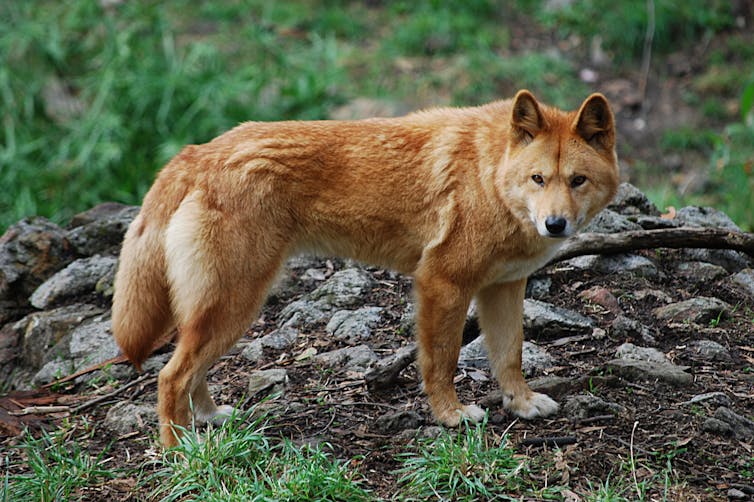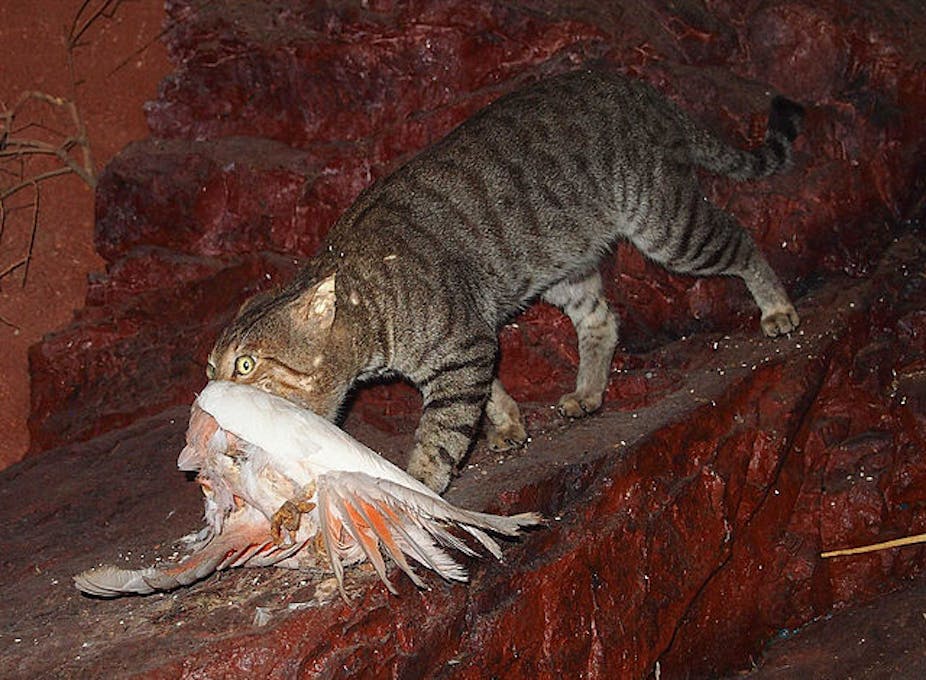In July 2015, the Australian government announced a “war on feral cats,” with the intention of killing over two million felines by 2020. The threat abatement plan to enforce this policy includes a mix of shooting, trapping and a reputedly “humane” poison.
Some conservationists in Australia are hailing this as an important step toward the rewilding of Australia’s outback, or the idea of restoring the continent’s biodiversity to its state prior to European contact. Momentum has also been building in the United States for similar action to protect the many animals outdoor cats kill every year.
In opposition are animal advocates including the British singer Morrissey who are appalled at the rhetoric of a war on cats and promote nonlethal methods of controlling the negative effects of cats as being more effective and humane.
Who is right? The truth lies somewhere in between and is a matter of both science and ethics.
Guesstimates
Today’s house cat (Felis catus) originated as the North African wildcat (Felis silvestris lybica). When a house cat roams or lives outside, it is called an outdoor cat. This category includes cats who are owned, abandoned or lost. Feral cats are house cats who have reverted to the wild, and are generally born and raised without human companionship or socialization. This makes a huge difference in their behavior.
After a certain point as kittens, cats are almost impossible to socialize and are “feral” – from the Latin term ferus for wild. While there is a related debate over whether house cats are domesticated at all, they have nevertheless so thoroughly infiltrated human societies that they are now distributed throughout the world, and along with dogs are humankind’s favorite mammalian companion animal.
From a scientific perspective, there is little doubt that under particular geographic and ecological conditions, outdoor cats can threaten native species. This is especially true on oceanic islands whose wildlife evolved without cats and are consequently unadapted to feline predators. For example, when cats were introduced to Pacific islands by European colonists, their numbers grew until they frequently posed a threat to native wildlife.

On mainlands, areas of high biodiversity that are isolated from surrounding habitats can respond like “terrestrial islands” to introduced species. In Australia, cats can be a threat to quolls, a carnivorous marsupial, and other indigenous wildlife if dingoes or Tasmanian devils are not around to keep them in check. A similar situation occurs in North American cities and countrysides, where coyotes vastly reduce the impact of outdoor cats on wildlife.
This ability to disturb ecological communities should come as no surprise. Scientists often refer to species as native, exotic or invasive. While there are historical criteria that play a role in making this determination, it is primarily a value judgment about where a species comes from, and whether it has a positive, neutral or destructive impact on the environment. Over the course of time, ecological communities adapt and immigrant species become native to their place. The baseline for assessing damage is usually the natural world as it was before the European age of exploration.
Cats are indeed an exotic species outside their ancestral home (Europe and North Africa), and they interact with the natural environment in myriad ways. They can also run amok by the standards noted above. However, whether cats are judged destructive is really a matter of context. Isolated Pacific islands that have never seen a cat are a far cry from cities where they are a normal element of urban ecology.
Of course, we might say the same about humans, although outside of extremists’ debates over politics and immigration, we do not use these terms nor advocate the mass slaughter of other people. We recognize this to be unethical.
Still, some conservationists claim that cats are the single largest threat to biodiversity regardless of ecological context. One oft-cited study in Nature Communications claims that 1.4 to 3.7 billion birds and 6.9 to 20.7 billion small mammals are killed by cats every year in the United States alone. Yet the scientific case for this claim is shaky at best.
Why? Virtually every study of outdoor cats assumes that because cats in some habitats threaten biodiversity, they are a threat across all habitats everywhere. This is a projection from a small set of localized case studies to the world at large. In other words, a guesstimate.
This is why the ranges of birds and mammals preyed upon that are cited above are so wide. Such guesstimates are neither descriptive nor predictive of the world. Some advocates have criticized such studies as junk science. For a particularly sustained critique see Vox Felina, which aims to “improve the lives of feral cats” through more thorough discussion. I think calling the academic literature junk science overstates the case a tad. Such studies can improve our understanding about what happens in similar situations, even if they cannot be generalized to all cats everywhere.
These studies, though, make little effort to understand the complexities of outdoor cats interacting with wildlife. When they do, the picture they reveal is quite different from what the guesstimates assume.
For instance, kitty-cam studies show that most cats hang out, visit the neighbors and do not travel far from home. In addition, if there are competing predators nearby, they tend to exclude cats from the area. This is particularly true of coyotes in the North America, and is thought to be the case with dingoes and perhaps Tasmanian devils in Australia.

And shocking as it might seem, there are no empirical studies on just how many feral or outdoor cats exist. No one has actually tried to count the actual number of cats out there. All the numbers bandied about are guesstimates.
For example, it is common for the Australian press and authorities to claim there are roughly 20 million feral cats. Yet as ABC News in Australia discovered, these figures are unverifiable. Even the authors of the scientific report used to justify the war on cats admit there is no scientific basis for estimating the number of outdoor cats in Australia. Similar uncertainties apply to guesstimates about feral cats in Europe and North America. They exemplify the term “urban legend.”
So scientists really have no idea how many feral cats are in Australia or North America. What’s more, they have a poor grasp of how much of a real impact feral or nonferal cats make on wildlife.
If the science about cats and their impact on biodiversity is this unreliable, then why is Australia talking about a war against feral cats? Why are conservationists in North America in such a lather about instituting similar lethal control programs?
The answer: it is all about ethics.
Look in the mirror
While rarely voiced, many conservationists hold unarticulated moral norms about repairing the damage done to Mother Earth by human civilization.
The moral responsibilities of being good stewards of the Earth mean the protection of endangered species, the preservation of natural habitat, conserving resources, reducing pollution and so on. Given the depredations of the human species (as a whole) on the Earth’s other life forms and living systems, environmental conservation is indeed a praiseworthy goal. Especially when it considers how to rewild the Earth so that other species besides humans might thrive.
Yet this worldview suffers from a number of blind spots that many conservationist are simply unwilling to see.
The first is the moral value of individual animals. Most conservationists recognize the moral value of ecological systems. Aldo Leopold’s “land ethic” is a universal touchstone for this belief. Leopold held that humans and nature (collectively “the land”) were part of the same community to whom ethical responsibilities were owed. Yet conservationists still tend to view animals as biological machines, functional units of ecological processes, and commodities for human use.
The problem is that they fail to apply the lessons learned from their own dogs and cats – namely, that many nonhuman animals are feeling and thinking creatures and have intrinsic value in their own right. In other words, individual animals as well as ecological communities have moral value apart from any use we may have for them. This means we have ethical responsibilities to cats as well as to biodiversity, and need to do a better job of balancing the well-being of both.
The second blind spot is blaming the victim. Are cats any more of an invasive species than human beings? Who transported cats across the world so that they are now one of the most widely distributed mammalian carnivores? See John Bradwhaw’s Cat Sense (2013) for a history of this global distribution.
When compared to humanity’s destruction and degradation of habitats, extinction of species, and the sprawl of our cities and economic activity, are we really to believe that it is cats who are the enemy of biodiversity? And what about cats who “fit” into urban ecologies, taking the place of otherwise absent predators and contributing ecological services in the form of pest control? Blaming cats instead of humanity’s unsustainable behaviors seems too easy, too simple, and a deflection away from the species that is truly culpable for the sorry state of our world.
The third issue conservationists do not typically address is the questionable moral legitimacy of lethal management. Traditional conservation likes to think of lethal measures, such as hunting, trapping and poisoning, as an unproblematic tool for achieving management goals. The legitimacy of this rests on the assumption that “individuals don’t matter,” itself a reflection that only people and/or ecosystems, not individual animals, have intrinsic moral value.

Yet there is a powerful movement of wildlife advocates and managers pushing back against this presumption. Flying under various names like humane wildlife management and compassionate conservation – its proponents say we should consider the well-being of both ecosystems and individual animals. This is right not only because of the intrinsic value of the animals being managed, but because many of these animals require stable social structures to thrive.
While feral cats may live solitary lives, outdoor cats in general are very social, frequently living with human beings, being cared for as community cats and interacting with other felines in extended cat colonies. Out of respect for cats and the people who care for them, we should give preference to nonlethal alternatives in management first and foremost.
To be sure, advocates for outdoor cats often have their own scientific and ethical blind spots about cats on the whole and about nonlethal management strategies. There may even be times when the threat of feral cats to a vulnerable species is so great that lethal action may be justified.
Nevertheless, even the most ardent supporter of rewilding should admit that it is human beings who bear direct moral responsibility for the ongoing loss of biodiversity in our world. A war on cats ignores their intrinsic value, wrongly blames them for mistakes of our own making, and fails to adequately use nonlethal measures to manage cats and wildlife.
As an ethicist, I care about both native wildlife and cats. It is time to stop blaming the victim, face up to our own culpability and seek to rewild our world with an eye to the ethics of our actions. There is no justification for a war on outdoor cats – feral or otherwise – based on shaky science and an absence of ethical reasoning.

